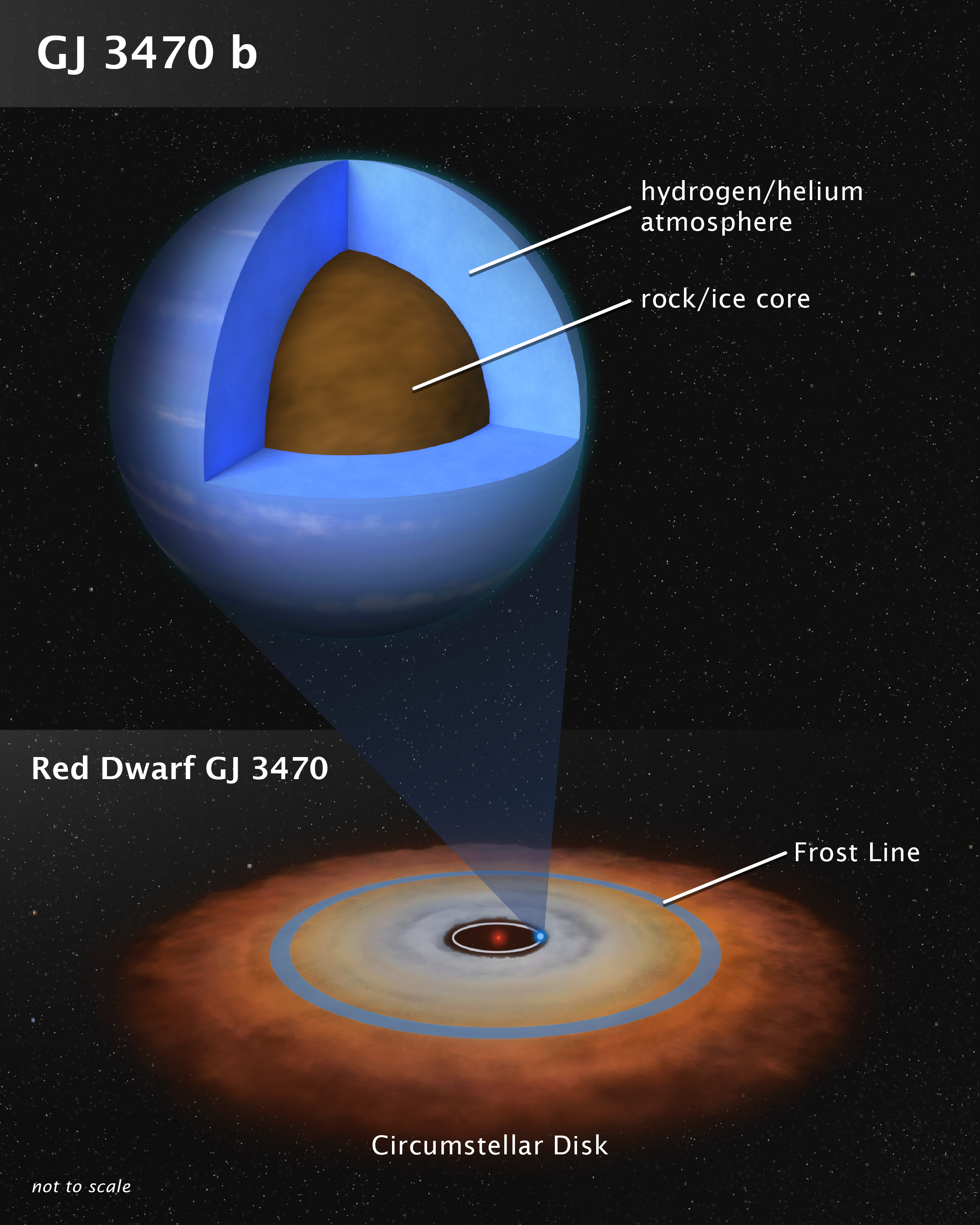Telescope Teamwork Reveals Gas Dwarf Planet's Atmosphere

Two NASA telescopes peered more closely than ever before at a planet shedding gas into space.
NASA's Hubble and Spitzer space telescopes together discovered the chemical "fingerprint" of the planet, called Gliese 3470 b or GJ 3470 b. The planet was already a puzzle because it orbits extremely close to its parent star that is literally evaporating. It's nearly 13 times the size of Earth, comparable to Neptune, which clocks in at 17 Earth masses. And what scientists found when they looked at the planet more closely was a big surprise.
The scientists predicted GJ 3470 b's atmosphere would be full of oxygen and carbon, the same elements that are at the root of the water vapor and methane gas observed at Neptune. "Instead, we found an atmosphere that is so poor in heavy elements that its composition resembles the hydrogen- [and] helium-rich composition of the sun," Björn Benneke, lead author on the new research and an astronomer at the University of Montreal, said in a statement.
Related: The Most Fascinating Exoplanets of 2018
What's more, the team thinks they may know why GJ 3470 b's composition is so different than that of Neptune's: It has to do with the planet's origin story.
Astronomers have already spotted many much larger exoplanets that orbit extremely close to their parent stars, known as "hot Jupiters." Many scientists suspect that these Jupiter-size planets formed farther out in their respective solar systems before migrating in toward their stars.
That's not the case for GJ 3470 b, however. The star likely formed just where it is now, extremely close to a red dwarf star that is about half the size of our own sun. The planet probably started out as a dry rock, and then picked up hydrogen from the gas disk surrounding the star when the star was very young. (This is called a "protoplanetary disk" and is a common feature in young star systems.)
Get the Space.com Newsletter
Breaking space news, the latest updates on rocket launches, skywatching events and more!
Commonly, planets such as GJ 3470 b rapidly grow into hot Jupiters, but that's clearly not the case here. "This is an intriguing regime," Benneke said. One explanation could be that the disk of protoplanetary gas somehow dispersed while the planet was still growing, stunting its size forever.
The two NASA telescopes did their work by studying the planet closely as it orbited around the star. Fortunately for scientists, GJ 3470 b passes directly across the disk of its parent star, which allows scientists to pick out the chemical fingerprint of the planet through spectroscopy. The researchers looked at two features of the star's light: how much light was absorbed by the planet as it passed in front of its star (which they observed 12 times) and how much reflected light was lost from the planet when it went behind the star (which they observed 20 times).
Chances are, astronomers will be stuck on the GJ 3470 b puzzle until they have access to a more powerful observatory — but one is on its way to orbit in a few years. NASA's James Webb Space Telescope could probe the planet after the observatory launches in 2021 or so. Webb is more sensitive to the infrared wavelengths in which the planet shines brightly, so it will be able to see more detail about the world than Hubble or Spitzer can, the team said.
A paper based on the research was published July 1 in the journal Nature Astronomy.
- Sweet Super-Puffs: These 2 Exoplanets Have the Density of Cotton Candy
- Exoplanet Hunters Have a New Plan to Spot Hidden 'Migrating' Worlds
- The Strangest Alien Planets (Gallery)
Follow Elizabeth Howell on Twitter @howellspace. Follow us on Twitter @Spacedotcom and on Facebook.
Join our Space Forums to keep talking space on the latest missions, night sky and more! And if you have a news tip, correction or comment, let us know at: community@space.com.

Elizabeth Howell (she/her), Ph.D., was a staff writer in the spaceflight channel between 2022 and 2024 specializing in Canadian space news. She was contributing writer for Space.com for 10 years from 2012 to 2024. Elizabeth's reporting includes multiple exclusives with the White House, leading world coverage about a lost-and-found space tomato on the International Space Station, witnessing five human spaceflight launches on two continents, flying parabolic, working inside a spacesuit, and participating in a simulated Mars mission. Her latest book, "Why Am I Taller?" (ECW Press, 2022) is co-written with astronaut Dave Williams.









